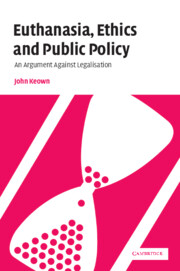Book contents
- Frontmatter
- Contents
- Preface
- Foreword
- Acknowledgments
- Table of cases
- List of abbreviations
- Introduction
- PART I Definitions
- PART II The ethical debate: human life, autonomy, legal hypocrisy, and the slippery slope
- 4 The value of human life
- 5 The value of autonomy
- 6 Legal hypocrisy?
- 7 The slippery slope arguments
- PART III The Dutch experience: controlling VAE? condoning NVAE?
- PART IV Australia and the United States
- PART V Expert opinion
- PART VI Passive euthanasia: withholding/withdrawing treatment and tube-feeding with intent to kill
- Conclusions
- Afterword
- Bibliography
- Index
6 - Legal hypocrisy?
Published online by Cambridge University Press: 20 July 2009
- Frontmatter
- Contents
- Preface
- Foreword
- Acknowledgments
- Table of cases
- List of abbreviations
- Introduction
- PART I Definitions
- PART II The ethical debate: human life, autonomy, legal hypocrisy, and the slippery slope
- 4 The value of human life
- 5 The value of autonomy
- 6 Legal hypocrisy?
- 7 The slippery slope arguments
- PART III The Dutch experience: controlling VAE? condoning NVAE?
- PART IV Australia and the United States
- PART V Expert opinion
- PART VI Passive euthanasia: withholding/withdrawing treatment and tube-feeding with intent to kill
- Conclusions
- Afterword
- Bibliography
- Index
Summary
A third argument prominently deployed in favour of legalising VAE is that the present law is hypocritical. It is argued that, while the law prohibits VAE in theory, it is unenforced in practice, and that this inaction against what is a common practice betrays tacit approval. In other words, while the law ostensibly sets its face against VAE, it nevertheless winks at it. The law's alleged hypocrisy is compounded, the argument continues, by the fact that while it prohibits doctors from administering or handing lethal drugs to patients it nevertheless allows doctors intentionally to end patients' lives, and help patients end their own lives, in other ways.
The current law
VAE as murder
Before evaluating these criticisms, we need first to consider what the state of the law is. We shall outline the law in England, though the law in other jurisdictions whose law is derived from English law, such as the USA, Canada, Australia and New Zealand, is similar. To begin with, we shall consider which of the three competing moral approaches outlined in chapter 4 the law adopts.
The law has never adopted vitalism: doctors have never been under a duty to preserve life at all costs. Nor has the law historically accepted the ‘Quality of life’ approach – that only those with ‘worthwhile’ lives have a right not to be killed. Rather, the law has traditionally adopted the inviolability principle.
- Type
- Chapter
- Information
- Euthanasia, Ethics and Public PolicyAn Argument Against Legalisation, pp. 58 - 69Publisher: Cambridge University PressPrint publication year: 2002

